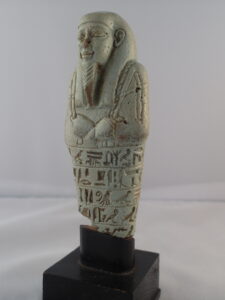
Shabtis are ancient Egyptian funerary figures that were placed inside the tomb of the deceased. Their function changed it time, from when they first appeared in the Middle Kingdom (around 2000 BC) till the end in the Ptolemaic period around 30 BC.
It started out in the Middle Kingdom as a representation of the deceased owner himself and as such where generally placed in a miniature coffin themselves.
During the Second Intermediate Period (around 1782 till 1570 BC) the use and quality of the shabtis declined. Among the few survivors of this period are mainly 17th dynasty so called “stick shabtis”, very crude wooden shabtis in a stick form, often inscribed in hieratic.

During the start of the New Kingdom (1570 BC) the shabtis were made in the best possibly quality, resulting from the wealth of the Egyptians in that period. At this point in time the numbers of shabtis increased till 10 to 40 shabtis per owner (even much more for members of the royal family and the pharao’s themselves) and their function started to change as well. Now they became the workers in the after life on behalf of the deceased owner. Since the ancient Egyptians believed that the after life
would be similar to life in Egypt, they were afraid of having to work on the lands again in after life. The shabtis and funery servants were to replace the owner in performing these tasks. As such they were holding implements as hoes, waterpots, bricks and so on.
By the end of the New Kingdom the quality declined again and shabtis were mass produced for everyone, even for the poor souls working on the tombs et cetera.

At the start of the Third Intermediate Period (1069 BC), the priests ruled Egypt. The function of shabtis changed again as they were now being divided into “overseer” shabtis and worker shabtis. The overseers were holding whips to control the workers who were know to be regarded as slaves. The numbers were more or less fixed at 365 workers shabtis (one for each day of the Egyptian year) and 36 overseers controlling each 10 workers, totalling 401 shabtis. The quality of the workmanship was average, although the typical blue faience of this period is considered by some as the best. This number remained the benchmark for the shabtis till the end.

After the 21 dynasty (around 720 BC), shabti quality decreased again and some of the smallest and most crude shabtis were made in this period. At the end of the 25 Dynasty and the start of the 26 Dynasty around 525 BC, the shabti quality reached new heights at this “renaissance” in ancient Egyptian culture, till the 30th dynasty. In the Ptolemaic period (330-30 BC) shabtis were made in different quality, sometimes with fake inscriptions or no inscription at all cause less and less Egyptians knew how to write hieroglyphs and people started to lose faith in the Osiris culture in general.
Here you will find some of my favourite links relating to shabtis.
